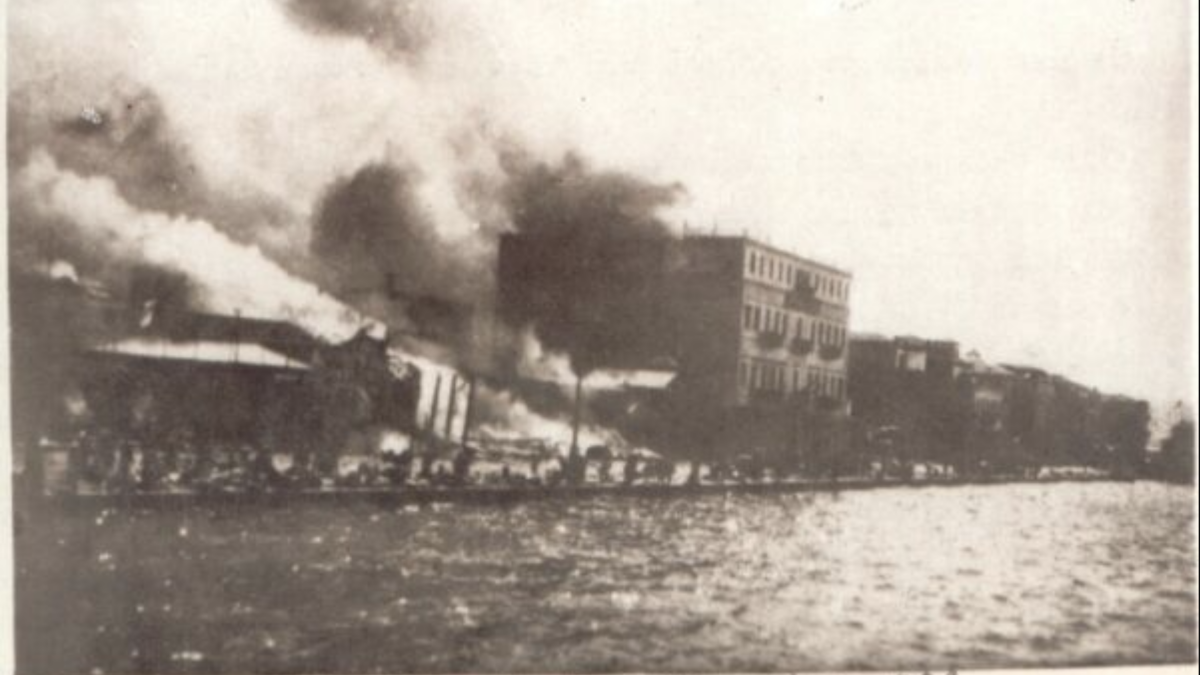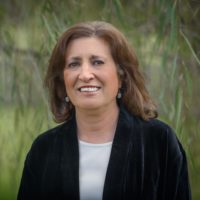Exactly 100 years ago, one of the most horrific fires of the twentieth century demolished the beautiful cosmopolitan port city of Smyrna — known today as Izmir — in Turkey. It burned for nine days during Sept. 13-22, 1922. Its historical significance cannot be overstated, but far too few people know about it.
In many ways, the burning of Smyrna stands alone among the great city fires of history. It was caused by numerous acts of arson and represented the culmination of the dechristianization of Turkey since it essentially drove out what remained of the Greek and Armenian populations. It finalized the era of Armenian genocide and brought the Greco-Turkish war to a decisive end.
Also noteworthy was the astonishing lack of first responders. There were dozens of allied warships in Smyrna’s harbor — French, British, Italian, and American — whose governments had the resources to at least offer humanitarian aid but held back because of commercial and geopolitical interests.
One of the most significant lessons to glean from the Smyrna fire is how the actions of individuals can make huge differences in the course of countless lives. History unfolds around people who take the initiative and responsibility for themselves and those around them even amid tragic forces. Such individuals have a high level of immunity to groupthink and tend to be determined and persistent. These qualities, including choosing individualism over succumbing to the mob, make them our greatest hope on every level.
This lesson is driven home by two distinct subplots within the story of the great fire of Smyrna. One is the gripping narrative of Asa Jennings, told brilliantly by Lou Ureneck in his recent book “Smyrna, September 1922.” Jennings was a sickly but cheerful Methodist pastor and lowly YMCA worker from upstate New York. He was ultimately the savior of hundreds of thousands of refugees left hopeless on the quay of desolate Smyrna.
The other plotline is more personal: my grandfather’s story.
The Background
In the early 1900s, Smyrna was often compared to Paris for its vibrancy, prosperity, and diversity. Greeks comprised nearly half the population of about 300,000, outnumbering Turks by a ratio of about two to one, according to some scholars. There were sizable minorities of Armenians, Jews, and Europeans as well. The city was so cosmopolitan, a bustling center of commerce with many banks, consulates, theaters, operas, nightclubs, and more, that Turks often referred to it as “Infidel Smyrna.”
After World War I, the Treaty of Sevres gave Greece jurisdiction over Smyrna and other critical territories. It was negotiated in 1920 between the Ottoman Empire and Allied Powers, primarily France, Great Britain, and Italy. The treaty also carved up a lot of the Ottoman territory as spheres of influence and occupation for those allies.
The terms of Sevres caused much anger and bitterness among the Turks. The occupation of Ottoman territory led to a huge rise in Turkish nationalism and the military rise of Mustafa Kemal Ataturk, the father of modern Turkey. Kemal’s army would eventually push westward with such force that by August 1922 the Greek army was in full disarray and retreating.
As they fled, vast numbers of Greek civilians also fled the surrounding villages, headed for Smyrna, where they assumed they’d be safe because of the presence of allied warships in the harbor. The remains of the Greek army finally evacuated Smyrna just before Kemalist forces captured the city on Sept. 9. The fire exploded a few days after that. Up to 125,000 are estimated to have been killed in the ensuing violence and the fire.
Smyrna’s Quay Before the Fire
Khatcher Matosian was my maternal grandfather and a survivor of the Smyrna fire who left details of it in his memoirs. After surviving the Armenian genocide in Ottoman Turkey during 1915 and 1916, he wandered from place to place with remaining kin.
In 1920, he and my grandmother with their infant son finally settled in beautiful Smyrna. Like other Armenians there, my grandfather made a living as an expert weaver of carpets and other textiles.
On Sept.9, he was on the waterfront arranging passage for 200 of his village compatriots on a Dutch ship. But it was too late. The first of Kemal’s cavalry entered Smyrna at that very moment. My grandfather and others watched wide-eyed. He describes the scene:
They were holding their bared swords high, calling out ‘Allah, Allah’ as they proceeded. But those who followed were rag-tag troops. Some were riding horses bareback. Some were barefoot. Their whole number did not pass 500. It took hardly ten minutes for the whole force to pass. Following them came an open automobile carrying four fez-wearing pashas. We learned they were the governor and Noureddin who occupied Smyrna.
The soldiers would quickly be followed by greater and greater numbers of Turkish forces.
Pillaging, looting, raping, and killing then began in the Armenian and Greek quarters of the city. Much of it was initiated by Turkish irregular military forces, also known as chetes — criminals initially set free by the Ottoman government in order to spread terror.
The churches and churchyards of Smyrna were soon filled with terrorized refugees hoping to find safety. My grandparents’ group first took refuge at the magnificent Armenian Cathedral of St. Stephen, which would soon be destroyed sometime after soldiers surrounded the church with cannons and ordered everyone out.
They managed to cut through the chaos and make their way to the waterfront. But all of the consulates and other prominent buildings lining the quay were tightly locked. By chance, my grandfather saw the door ajar of a casino that was flying the Union Jack. They slipped in and took refuge, joining about thirty others already in there.
The British casino owner was kind to them, and my grandfather’s English was good enough to converse. They were horrified as they watched through the basement window at the gruesome goings-on, like young men “stripped naked in the flower of their youth forced to run to their execution.” There were grotesque scenes of torture and beatings and wailing of biblical proportions.
Marble Buildings ‘Burning Like Oil‘
Prominent scholars of Smyrna, including Majorie Housepian, usually cite Miss Minnie Mills as the first eyewitness reporting the fire. Mills was the director of the American Collegiate Institute for Girls located in the Armenian Quarter in Smyrna. At lunchtime on Sept. 13, she looked outside and “saw a Turkish officer enter the house with small tins of petroleum or benzine and in a few minutes the house was in flames.”
Others at the school reported seeing Turkish officers “using long sticks with rags at the end which were dipped in a can of liquid and carried into houses which were soon burning.” A hot desert wind was blowing northward, fanning the flames more deeply into the Armenian and Greek quarters, and away from the Turkish quarters.
My grandfather, still in the casino, noticed the crowd outside swelling rapidly, and soon learned it was due to a fire. Although there was no food, the casino owner had offered the refugees “plenty of water.” My grandmother Sophie and her friend Lucia were soon spending many hours refilling and passing out vessels of water through the basement window to parched refugees outside. But pipes in the city would soon melt from the fire, cutting off the supply.
By nightfall, the casino owner suggested they go up to the roof to check the extent of the fire. According to my grandfather, “No mortal could describe such a horrible scene. The dense smoke had blocked out the sky. At some spots the flames were shooting a thousand feet into the air.” He described how the crackling of the fire was punctuated by explosions and how enormous and tall buildings were engulfed in flames:
These buildings of marble were burning like oil … Each building would catch fire from the next. The intense heat from one building would first blast the windows of the building next to it. The flames would enter the windows and ignite the contents. Then in a short while we would see the flames shooting up through the roof of the building.
It burned so hot, according to Ureneck’s research, that the hemp hawser lines on some of the ships in the harbor were igniting. The waterfront quay was wall-to-wall people, soon hundreds of thousands, with little space to move. Many had bundles of earthly goods, which ignited and caused bonfires along the quay.
Donkeys and horses stampeded madly when packs caught fire on their backs. My grandfather noted that the panic from the quay’s walls pushed many people into the sea. And the walls of buildings were collapsing into the street.
The next day his casino benefactor bid them all a sad farewell and evacuated with the other British citizens. Soon afterward, it wasn’t safe to stay indoors, so they went out to the quay.
Trapped Between Fire, Water, and Swords
“But where could one go?” my grandfather wrote. Turkish soldiers were boxing in the refugees on either end of the two-mile quay. “In front of us water, in back of us flames, and on both sides the enemy’s sword.”
My grandfather reported that soldiers then moved through the crowd on horseback telling everyone to go toward Karatash, to the south of the quay, saying, “There’s no fire in Karatash!” According to my grandfather, “All at once there was a massive movement, like mighty waves of the ocean” in the direction of Karatash.
Grandpa didn’t bite. The many who desperately followed those directions suddenly opened up his place on the quay with much extra space. He advised his small group to stay put and wait it out. They soaked their carpets with seawater and used them as tents to protect themselves from the sparks and smoldering debris showering down in the night.
By the grace of God, a small motor launch approached that could take them and others to a ship in the harbor that was actually taking refugees on board. They were among the very few blessed to evacuate Smyrna so early. Many thousands of others would wait two weeks more.
How Asa Jennings Bent History
Miraculous on a grand scale is the story of that five-foot-tall missionary who was hunch-backed from Potts Disease. To get a full story of Jennings’ feat of evacuating some 300,000 refugees from the Smyrna quay in just seven days, watch the 45-minute documentary “Smyrna: Paradise is Burning” and read Ureneck’s book.
Since none of the Allied Powers would coordinate an evacuation of the refugees, Jennings took it upon himself to devise a rescue plan. At one point, as Ureneck explains, Jennings got permission through a bribe to get a good number of refugees aboard an Italian ship to take them to the Greek island of Lesbos. While on that journey, he noticed a fleet of Greek merchant ships standing idle after being used to evacuate the Greek army from Turkey.
Jennings used every means at his disposal to get access to those ships to take the Smyrna refugees to Greece. This included telling some lies, misrepresenting himself, a bit of blackmail, and excellent relationships with those who could help him in his plan. One of those was sympathetic U.S. Navy commander Halsey Powell, who negotiated the evacuation with the Turks even though Admiral Mark Bristol, U.S. high commissioner in Constantinople, was vehemently opposed to U.S. involvement with an evacuation.
Meanwhile, Jennings was working out an evacuation plan with Greek naval commander Ioannis Theophanides. In the end, Jennings, a man with no military experience, commanded under the American flag a fleet of some twenty flagless Greek merchant ships that came into Smyrna harbor on Sept. 22 to the jubilation of the crowds on the quay. The Turks allowed only seven days to complete the task and would not allow any military-age men to evacuate. But all others were evacuated by the deadline of Sept. 30.
Actions of the Individual
As with Jennings, there are many marvels in my grandfather’s story, not least of which he survived despite being a young man of military age — 22 at the start of the genocide in 1915 and about 30 during the fire. (The official records that saved him early on showed a much younger age. His short stature would have also helped.)
He was observant and was always working out ways to keep his group of kin and compatriots together. That often meant sneaking through chaotic and dangerous conditions. It definitely helped that he could save much money as a highly-skilled carpet weaver during better times in Smyrna because the ability to bribe was often a matter of survival in those times and places.
Like Jennings, my grandfather had to rely on his wits and some misrepresentation in order to save others, as well as himself. On different scales and in their own ways Asa Jennings and Khatcher Matosian were prescient, determined, brave, persistent, and independent thinkers. The power of such individuals is a critical lesson in history.
There’s also a 21st-century lesson from the Great Fire of Smyrna: so many Americans today have no real concept of the difference between tyranny and freedom. I know that I am here because of the great deeds of individuals like my grandfather, through the grace of God. Such feats are never accomplished by groupthink or acquiescence to tyrannical and bureaucratic forces. They require a great level of shrewdness, as well as persistence and compassion. And a heavy dose of faith.









